Executing well at retail is something that every brand must master if they want to succeed. Once customers are already in the store, how do you get them to interact with and eventually buy your products? The answer lies in your point of purchase marketing.
By effectively reaching customers within the store, you can increase your sales without greatly increasing your budget. Point of purchase marketing can be the key to easily improving your brand’s performance at retail relative to the competition. First, let’s dive deeper into what point of purchase actually is.
What is Point of Purchase Marketing?
Point of purchase is defined as any part of a store where a customer engages with your product. POP displays themselves are displays that exist separate from the standard aisle shelf, effectively inserting a product into a shopper’s path through the store.
Point of Purchase vs. Point of Sale
A common misconception is that point of purchase refers only to the space within the store where the transfer of money for the goods occurs, such as the register. Point of purchase can be broader than this, and actually accounts for the entire store.
The actual register line is usually referred to as the “point of sale,” because it is at this point that the buyer has given over their money and completed the sale. Oftentimes these two terms are used interchangeably, but think of point of sale as a more narrow way to look at point of purchase.
By these definitions, point of purchase marketing can be understood as whatever marketing or merchandising materials your brand provides to its retailers in order to help sales of your product in the store, or whatever materials you include with your product to accompany it where it is displayed.
6 Benefits of Effective Point of Purchase Displays
Effective point of purchase displays have many advantages in store, and can help both retailers and buyers to love your brand. Point of purchase displays have been shown to increase sales at retail as much as 20 percent! To break this down, here are the top six advantages of effective point of purchase displays.
Catch the Customer’s Eye
Shoppers in a store are known to be “skimmers,” meaning that they’ll skim down the aisle looking for one thing in particular. Packaging alone, no matter how catchy or visually appealing, is often too small to make an impact on a customer without a little help. That’s where your display comes in. Using bigger mediums such as a cardboard display or hanging shelf sign to accompany your product increases the chance that a buyer will notice it.
Supplement Your Packaging
You’ve got a great product, and you want to communicate that to as many people as possible. There’s a lot you could say, but it’s hard to fit it all onto a small label or box. Enter point of purchase displays. In addition to making your brand easier to spot, they allow you more space to better educate buyers on the unique value that your product offers. This can be utilized by providing additional information that won’t fit on your packaging, or simply making your brand’s designs bigger to better help with branding.
Strategically Locate Your Products
Point of purchase displays are often free-standing, or attachments that can be fit onto the ends of shelves. This gives both you and your retailer a lot more flexibility as to where to put your product. You’re no longer getting squeezed in on the corner somewhere low on the shelf, but instead can be right in the middle of highly traversed areas within the store. This is also a great way to get your brand next to any complementary products it may be commonly used with, even if traditional shelf space isn’t available there.
Help Your Retailer Merchandize Your Products
A common struggle for brands is ensuring that their products are merchandised effectively at retail. This is limited by how well your retailer understands your brand, and by how much time and space they can devote to each of the many brands they need to promote. By providing a display along with your product, you are able to dictate exactly how you want your brand advertised within the store, saving both you and your retailers a lot of trouble.
Be More Cost Effective
Getting your brand an ad on most media platforms is always pricey. Point of purchase displays such as posters or signs are a way to say whatever you would have said in a magazine or on a billboard for a fraction of the cost. You can even use the same ads or messages, but simply tailor them to fit a store poster or cardboard display. As an added bonus, it’s easier to target to a more relevant audience who can be immediately impacted by your advertising.
Target Impulse Buyers
It’s much easier to entice customers to buy your product if they are already in a store with the purpose of buying something. A clever ad is more likely to have an effect if the person viewing it has the opportunity to buy that product right then and there. If shoppers are already making a purchase, there’s a better chance they’ll add something new onto it. Large numbers of purchases are often unplanned, especially in the food and beverage industry, meaning that effective point of purchase marketing can have a profound effect on your sales.
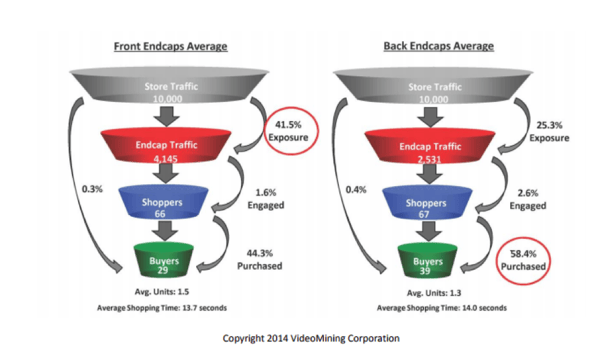
Image Source: Observa
30 Examples of Point of Purchase Displays
Shelf Talkers
Shelf talkers are hanging tags or signs that promote your product on an aisle shelf. They’re useful for a lot of reasons, including:
- Catching the customer’s eye
- Making your brand stand out within the aisle
- Pointing out promotions
- Educating the buyer about the product
Shelf talkers, also known as “hang-tags,” are a cheap and easy way to guide customers to your product in the aisle.
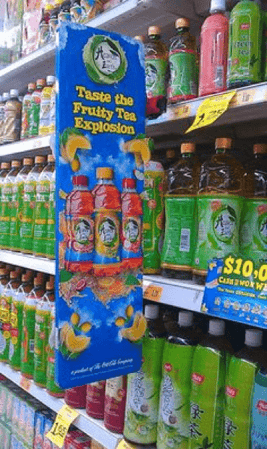
Image Source: SI Retail
This shelf talker uses bright colors and pictures to pop out from the shelf. It shows many different flavor options of the product, and uses fun words and images to draw customers in.
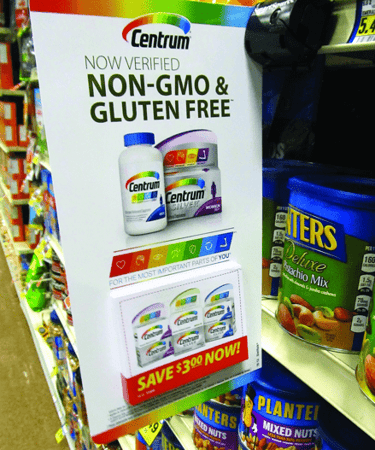
Image Source: Shopper Marketing
This Centrum ad is an ideal shelf talker. Not only is it bright and eye-catching, but it educates shoppers as well. “Now Verified Non-GMO and Gluten Free” is important news, so having that on a display as opposed to just the packaging is a good strategy.
Also, notice how there are promotions and coupons included in the ad, which is another way to attract buyers.
The only thing that could be improved about this point of purchase is the location. An ad for multivitamins should ideally be located in that aisle, not around peanuts and snacks. Even better, it would be directly next to Centrum products, so that customers looking at the shelf talker have the opportunity to grab the product.
Here’s a few more shelf talkers that have these great qualities:
Dump Bins
Dump bins are commonly used for small-packaging products that customers may want to grab a few of. They’re very common with candy bars or food accessories, in that they’re useful for stocking and selling large quantities. A great advantage of dump bins is that they are free standing, and can be strategically placed to be seen or interacted with from all angles. They are also a great opportunity to project your brand’s image on a large surface, and get creative with how you do it.
This particular display is a fantastic example of a catchy and effective dump bin. Who wouldn’t have their attention grabbed by a waist-high KitKat bar? In addition, it’s easily recognized as KitKat’s unique image, and entices shoppers to grab a few bars from the display in passing.
Check out these other examples!
Free Standing Displays
Free standing displays or cartons are great for a number of reasons. As mentioned before, they allow you more flexibility with your product’s location within the store, and are also really easy to implement. Since they’re commonly made out of cardboard, it’s a great chance to get creative and experiment with some attention-grabbing shapes or designs, such as making a giant version of your product.
Here is a perfect example of how to effectively do a free standing display. To start, it’s an in-your-face depiction of Jameson’s iconic bottle, again making it easily recognizable. The 360-degree display completely utilizes the floor location in that buyers can see it from any direction, and multiple shoppers can interact with it at one time. Last, it’s easy to tell when stocks are running low compared to a typical aisle shelf.
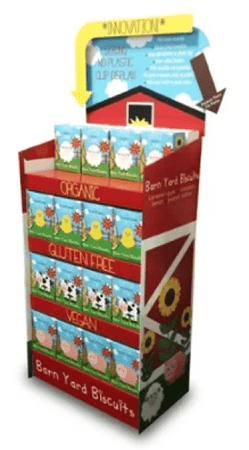
Image Source: ProCorr
This sample display shows many great qualities as well. It looks like a barn, which helps to project the brand’s organic image. Notice that it’s also very educational. Key selling points such as “organic” or “gluten free” are easily readable, in addition to more key information bulleted at the top. This is a great example of using a display to supplement your packaging, both by making the advantages of the product much bigger and easier to see, and also by providing additional information that might not fit on the box.
Use some of these ideas to get creative with your displays!
End Caps
End caps, as you probably inferred from the name, are displays that are placed at the end of an aisle where two aisle shelves sit back-to-back. Like free standing displays, end caps allow you to place your product in relevant areas without needing aisle shelf space. They also give you a prime location to attract a lot of eyes -- shoppers can see your display without even going down the aisle.
This end cap from KitKat does a lot of great things. In particular, notice how KitKat’s recent slogan “Have a break, have a KitKat” is front and center. It’s helpful if your in-store displays keep consistent with other marketing campaigns you may be running, so as to continually build your brand’s image. The six-foot candy bar has a way of attracting attention, too.
This end cap from Quest Nutrition follows a similar concept. That bright blue color is impossible to miss, as is the giant slogan on the bottom. Pay attention to the side panels of this cardboard display; they provide some important information about the unique value of the product. Last, the enormous pictures and logo at the top are important for branding, and displaying the many different types of Quest bars.
These other examples do a great job as well!
Floor Graphics
Floor graphics are another unique way to draw shoppers’ attention to your product as they go down the aisle. They ideally should be placed on an area in front of the shelf where your brand is stocked, so that customers can easily find your products after becoming intrigued by your display.
Consider this display from Ski Dairy. First off, it’s conveniently located directly in front of Ski’s products. The large graphic is much more effective in capturing attention than the packaging alone. In addition, this is a great example of using point of purchase displays as a larger medium to educate about your product. Key information such as “with probiotics” or “real fruit” are largely displayed, including a picture of the product so that shoppers can easily identify it.
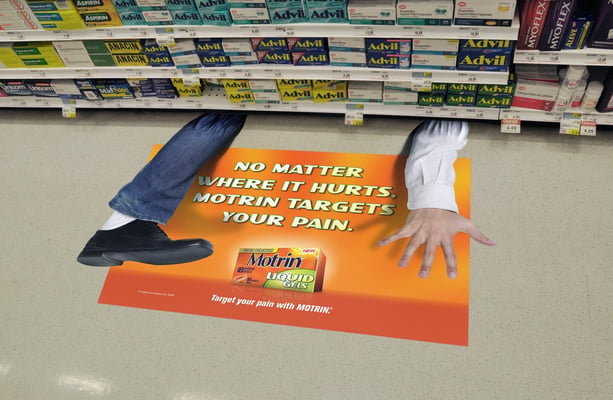
Image Source: Outdoor Advertising Association of America
This graphic from Motrin definitely gets the job done. It’s clever and creative, depicting a man being squashed underneath the shelf. That would clearly cause a good amount of pain, and it’s a great light hearted way to advertise a pain medication. The graphic is strategically placed, and allows Motrin to set themselves apart from the many other pain medications stocked in the same aisle.
How else can you turn the aisle floor into a display?
Best Point of Purchase Practices
Now that you’ve learned about point of purchase and seen some awesome examples of displays, how can you implement it with respect to your own brand?
All of these examples shared many characteristics in common, and these are the key takeaways to ace your point of purchase marketing:
Be Eye-Catching and Creative
Like we talked about before, the goal of many point of purchase displays is to grab the attention of shoppers as they skim up and down the aisle. The best way to do this is to make it as eye- catching as possible. Some common tools to do this are:
- Bright colors
- Large logos
- Pictures of the product
- Large print
- Catchy slogan or saying
- Unconventional shapes
This is a true chance to get creative with your marketing. Experiment with many different ways to grab the most attention from your buyers. Many competitor brands are going to be displayed as well, so find something that will set yours apart from the rest.
Location, Location, Location
Point of purchase displays give you more options for location than aisle shelves. They can be attached to the ends of aisles, free standing in open space, or hanging from an aisle shelf.
Use this to your advantage! Place your displays in more highly traversed areas of the store, such as the front or the ends of aisles. Place your displays closer to eye-level to increase their chances of being seen. Smaller items can be placed in the register line, where customers will be more enticed to buy something while they wait.
Another great way to use location is through cross-marketing. Cross-marketing is placing your product near complementary ones that would commonly be used together. For example, if you sell peanut butter, it would suit you to display your brand near jelly or bread. This works for two reasons. First, it can act as a “reminder” for someone buying one of the complements. Second, the convenience of having your product directly near other relevant products incentivizes buyers to just grab it there, without having to go somewhere else in the store.
Educate About Your Brand
Use your displays to communicate the unique value your brand provides on a larger scale. It’s a great opportunity for branding as well, so use any slogans, logos, or colors that you want to be associated with your product. Any key selling points, news, or information should be boldly displayed, and entice the buyer to pick up your product to learn more.
Point of purchase is key to increasing your sales and improving your overall performance at retail. Follow these tips and use ideas from these great examples to completely dominate the shelves!







.png?width=480&height=252&name=PRESS%20RELEASE-2%20(4).png)

